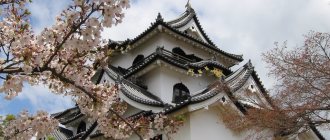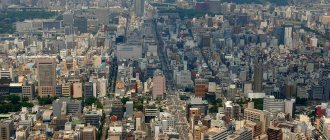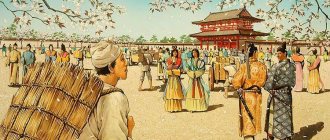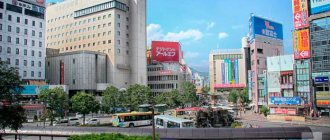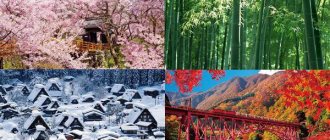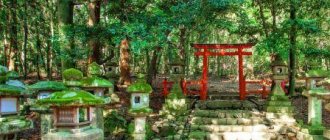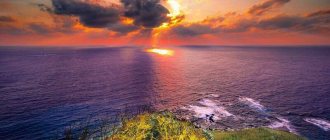Story
In the 13th century, samurai Akamatsu Norimura ordered the construction of a fortress on top of Himeyama Hill. A few years later, his relative rebuilt the fort into a palace - Himeji.
During the civil war of the 15th century, Himeji moved from one clan to another. Until in 1600 the castle was donated to Prince (Daimyo) Ikeda Terumasa for the Battle of Sekigahara. It was during his ownership that the main building was completed and other structures were erected, which have remained almost untouched to this day .
After Terumasa, Himeji was controlled by several prominent families, sold at auction, survived the bombing of World War II, was recognized as a UNESCO World Heritage Site, and became a favorite pilgrimage site for millions of tourists.
Please note: the number of visitors to Himeji Castle is limited to 15 thousand/day. Another reason to arrive early.
Himeji city in Japan. White Heron Castle
Himeji Castle has a second name - “Castle of the White Heron”, which it “received for its special refinement of forms and elegance, reminiscent of a beautiful snow-white bird.”
The small territory of Japan seems to be literally crammed with various attractions : all you have to do is discover this stunning country step by step.
So different and amazing, Japan seems to have one foot in the distant, distant future - which we Europeans can only vaguely imagine from science fiction films, and the other foot in the past, in traditions and history, which in Japan are treated with extreme respect.
The city of Himeji is a place where the ancient history of Japan is alive, and not only tourists, but also the Japanese themselves come here en masse to touch it. Our website Travel and the World around us will try to give you complete information about this.
Himeji, which lies in the southwest of Honshu, could have been the capital of Japan: after an earthquake in 1923, Tokyo was so devastated that the government seriously considered moving the capital to Himeji. However, in the end this plan remained only on paper.
The main, but not the only attraction of the city is the castle of the same name, which is located at the foot of Mount Hime. It was built in the first half of the 14th century and is one of the oldest surviving castles in Japan.
Moreover, what is most interesting, the word “preserved” in the case of this particular castle could not be more appropriate: the city of Himeji during World War II was subjected to heavy bombing by the US Army (there was an important railway junction and several military facilities), but the castle survived, even despite to the incendiary bombs that fell on him.
Having then survived the 1995 Kobe earthquake and smaller natural disasters, Himeji residents rightly believe that the castle has divine protection. The castle is one of the National Treasures of Japan, and since 1993 it has been on the UNESCO World Heritage List.
Himeji Castle has a second name - “Castle of the White Heron”, which it “received for its special refinement of forms and elegance, reminiscent of a beautiful snow-white bird.” The castle complex consists of 83 buildings, most of which are wooden.
Some of the buildings were built later than the foundation of the castle: for example, the 45-meter main tower, tenshu, and the garden surrounding the building appeared at the beginning of the 17th century. The park is notable for its ingenious landscape design: in fact, it is a labyrinth in the form of a spiral with dead ends and traps.
In this way, it was planned to protect the castle from attacks - to shoot at the invaders from the main tower while they wandered through the labyrinth. However, by the time the garden was built, the war period in Japan had ended, and it was not possible to verify the castle’s defenses in reality, but the park remained to serve an aesthetic function.
Now the park is a place where Japanese people travel from all over the country to take part in Hanami, the cherry blossom festival. Our website Travel and the World around us will try to give you complete information about this.
Sakura and other plants can also be seen at the Himeji Tegarayama Botanical Garden - its domed greenhouse is easy to find in the city's Central Park.
Another garden that is definitely worth a visit is the Koko-an Garden, built in honor of the centenary of the Himeji municipality, which consists of 9 smaller gardens: small ponds, gazebos, stones and picturesque vegetation turn the park into a wonderful place for walks, solitude and reflection.
The picturesque nature of Mount Seppiko attracts monks who practice Shugendo rituals here (unfortunately, because of this, women are not allowed to enter some places here so as not to interfere with preparations for the ceremony), and tourists who go hiking here.
On another mountain, Shosha, there is the Shoshazan Engyoji temple complex, built in the 10th century. By the way, some scenes of the film “The Last Samurai” were filmed in this temple (and Akira Kurosawa filmed films more than once in Himeji Castle).
.
